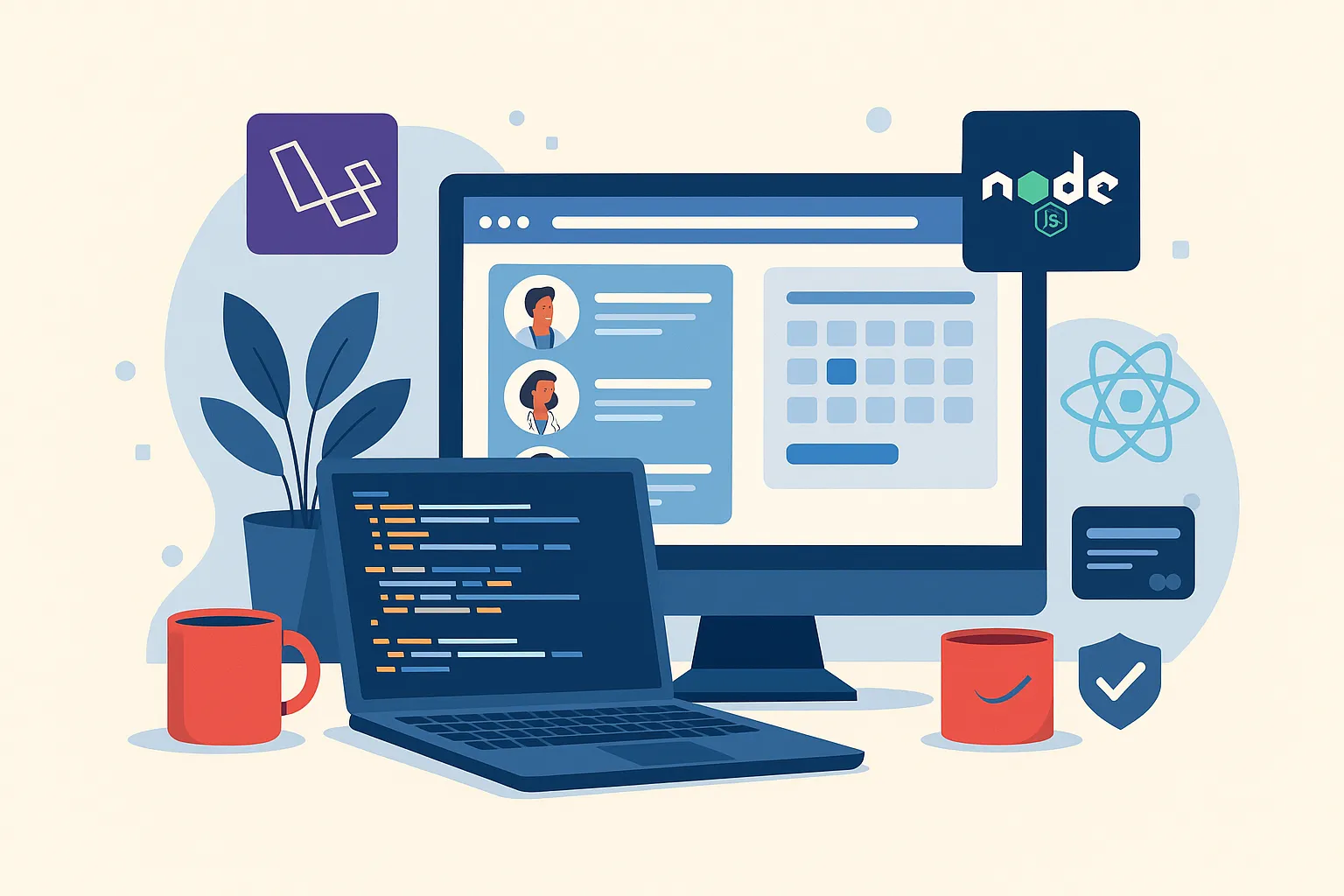In today’s healthcare ecosystem, app like Practo are bridging the gap between patients and healthcare providers — making it easier than ever to book doctor appointments, access medical records, consult virtually, and manage health services from a single interface.
As a full-stack developer who’s built a Practo Clone from scratch — across JavaScript (Node.js + React) and PHP (Laravel/CodeIgniter) stacks — I’m excited to walk you through every layer of the process. This guide is written with founders and dev-savvy entrepreneurs in mind — the kind of people who want to launch quickly, but with full control and flexibility.
Whether you’re considering a Practo-like app for your startup, a white-label product for clients, or a niche medical SaaS offering, this post will give you clarity on the tech stack, architecture, modules, implementation paths (JS vs PHP), and launch strategies.
Tech Stack: JavaScript vs PHP for Practo Clone Development
When building an app like Practo, your tech stack choice will shape not just development speed but also future scalability, third-party integrations, and team flexibility. I’ve developed Practo-like apps using both the JavaScript ecosystem (Node.js + React) and the PHP stack (Laravel or CodeIgniter)—each has its advantages depending on your priorities.
JavaScript Stack (Node.js + React)
If you’re aiming for a highly interactive, real-time experience—say, instant doctor confirmations, live chat for consultations, or dynamic calendar booking—then Node.js with React is hard to beat. React on the frontend offers a component-driven architecture that makes features like search filters, appointment modals, or prescription views feel buttery smooth. Meanwhile, Node.js on the backend (often paired with Express) gives you non-blocking performance and rapid API development. I usually pair this with MongoDB for a flexible, document-based database that works well with deeply nested data like patient history, medication logs, and appointment timelines.
PHP Stack (Laravel or CodeIgniter)
On the other hand, if your audience is more accustomed to straightforward, web-first usage, and you want to leverage PHP hosting environments (which are cheap and abundant), Laravel or CodeIgniter are great options. Laravel in particular brings elegance to routing, middleware, and database migrations. The Blade templating engine makes it easier to build responsive web views that are tightly integrated with backend logic. Laravel also has excellent support for queues (e.g., for sending emails or appointment reminders), authentication scaffolding, and multi-guard access control (essential for handling patients, doctors, and admins).
Choosing the Right Stack
In my experience, here’s how I help founders decide:
- Go with Node.js + React if: You plan to offer mobile-first usage, high interactivity, modern UX, or plan to scale aggressively with microservices.
- Choose Laravel/CI if: You need rapid MVPs, backend-heavy logic, cost-effective hosting, or want to leverage the rich PHP developer base for future maintenance.
Read More : Best Practo Clone Scripts in 2025: Features & Pricing Compared
Database Design: Flexible, Scalable, and Ready for Healthcare Workflows
A solid database design is the foundation of any Practo-like app. Whether you’re using MongoDB with Node.js or MySQL with Laravel/CI, the schema needs to support multiple user roles (patients, doctors, admins), dynamic schedules, health records, and transactions—without falling apart as the data grows.
Core Entities and Relationships
At the heart of the app, we have these primary models:
- Users (Patients, Doctors, Admins)
- Appointments
- Doctor Profiles
- Specializations
- Clinics/Hospitals
- Medical Records
- Payments
- Reviews/Feedback
Here’s a simplified relational schema I used for a Laravel-based Practo clone:
Users Table
- id (PK)
- name
- phone
- role (enum: patient, doctor, admin)
- password (hashed)
- status (active/suspended)
Doctor Profiles Table
- id (PK)
- user_id (FK to Users)
- specialization_id
- qualifications
- experience_years
- available_days (JSON)
- time_slots (JSON)
Appointments Table
- id (PK)
- patient_id (FK to Users)
- doctor_id (FK to Users)
- appointment_date
- time_slot
- status (booked, completed, cancelled)
- consultation_type (online/offline)
Medical Records Table
- id (PK)
- patient_id
- doctor_id
- diagnosis
- prescription (JSON)
- notes
- created_at
Payments Table
- id (PK)
- appointment_id (FK)
- amount
- status (success, failed)
- method (Stripe, Razorpay)
MongoDB Schema (Node.js Approach)
In a Node.js + MongoDB setup, I designed collections like this:
users
{
"_id": ObjectId,
"name": "John Doe",
"email": "[email protected]",
"role": "patient",
"password": "...",
"medicalHistory": [...],
"appointments": [...]
}appointments
{
"_id": ObjectId,
"patientId": ObjectId,
"doctorId": ObjectId,
"date": "2025-07-28",
"slot": "10:30 AM",
"status": "booked",
"paymentStatus": "success"
}
doctors
{
"_id": ObjectId,
"userId": ObjectId,
"specializations": ["Cardiology", "General Medicine"],
"availableDays": ["Monday", "Wednesday"],
"slots": {
"Monday": ["10:00", "11:00", "14:00"],
"Wednesday": ["09:00", "13:00"]
}
}
Flexibility and Scalability
I prefer using JSON fields or nested arrays where flexible data is required—like doctor availability or custom health notes. MongoDB shines here, while Laravel with MySQL supports JSON columns too if you structure them right.
For scaling, I index foreign keys (doctor_id, patient_id) heavily, and apply caching (Redis) for frequent queries like “doctors by specialization”.
Read More : How to Build an App like Practo: A Complete Guide to Telemedicine Success
Key Modules and Features: How It All Comes Together
When building an app like Practo, modularity is everything. You need core systems that handle bookings, real-time availability, user roles, and search—without coupling everything together. I’ll walk you through how I structured major modules in both the Node.js + React and Laravel/CI versions.
1. Appointment Booking System
In Node.js:
I used Express routes with Mongoose models to check slot availability in real time, lock it in, and trigger downstream processes like confirmation emails or payment status updates. Here’s a simplified flow:
/appointments/check→ Validates if doctor is available/appointments/book→ Creates appointment and triggers email job- Slots are locked using atomic MongoDB updates to prevent double booking
In Laravel:
I used Eloquent models with service classes to decouple logic. The AppointmentController handles request validation, while services handle business rules. Events and listeners manage side-effects like notifications or record updates. Laravel’s built-in scheduler helps with slot reminders.
2. Doctor Search and Filters
Search is a high-traffic feature, so I optimized it with both basic SQL queries (PHP) and MongoDB text indexes (Node).
Node.js:
Doctor.find({
specializations: { $regex: req.query.specialization, $options: 'i' },
"slots.Monday": { $exists: true }
})
Laravel:
Doctor::where('specialization', 'LIKE', "%$request->specialization%")
->whereJsonContains('available_days', 'Monday')
->get();
In both, I added pagination and filter combinations for:
- Specializations
- Location (geo-coordinates or city)
- Availability day/time
- Ratings
3. Admin Panel
For both stacks, I built a separate backend UI:
- React (admin.mydomain.com) for Node.js apps
- Blade templated backend (/admin) for Laravel apps
Admin features include:
- Doctor onboarding and approvals
- Appointment status control
- User management and suspension
- Revenue dashboard (Stripe or Razorpay integration)
- Email template editors
4. Reviews and Ratings
Stored one review per patient-doctor pair per appointment. Protected with logic to only allow after appointment status = completed.
Node.js: Stored under doctorId with average score recomputed on write
Laravel: Used a DoctorReview model and recalculated via Observer hooks
5. Notifications (Email/SMS/Push)
- In Node.js, I used Nodemailer and Firebase Cloud Messaging for email and push
- In Laravel, I used built-in Notification channels and
queue:workfor async sending
This modular approach ensured that even when the client wanted to extend it later with teleconsultation or e-pharmacy, the codebase was clean and pluggable.
Read More : Practo Feature Breakdown: What Startups Can Learn
Data Handling: Third-Party APIs and Manual Listings
Whether you’re building a local doctor discovery platform or a global health consultation hub, the flexibility to handle both dynamic third-party data and admin-controlled listings is crucial. In the Practo Clone I developed, we supported both modes cleanly in both the JavaScript and PHP versions.
1. Third-Party API Integration
While Practo itself doesn’t rely on external APIs like Amadeus or Skyscanner, many founders I’ve worked with wanted to offer medical tourism—booking doctors abroad, bundling hotels, or syncing flight data. Here’s how we handled that:
In Node.js:
I built service modules that handled API authentication, data fetching, and caching:
- Used Axios for making HTTP calls
- Cached results in Redis to avoid API throttling
- Normalized response data into our internal structure
Sample integration with Amadeus (Node):
const flights = await axios.get('https://test.api.amadeus.com/v2/shopping/flight-offers', {
headers: { Authorization: `Bearer ${token}` },
params: {
originLocationCode: 'DEL',
destinationLocationCode: 'BKK',
departureDate: '2025-08-01'
}
})In Laravel:
I created API service classes using Guzzle and Laravel’s Job Queue to fetch and cache data periodically:
$response = Http::withToken($token)->get('https://test.api.amadeus.com/v2/shopping/flight-offers', [
'originLocationCode' => 'DEL',
'destinationLocationCode' => 'BKK',
'departureDate' => '2025-08-01'
]);These APIs helped offer users a full-package medical travel experience: doctor + travel + stay.
2. Manual Listings via Admin Panel
Manual listings are essential for onboarding small clinics, local doctors, or temporary services (e.g., vaccination drives). Both stacks had an intuitive admin form interface for:
- Adding doctors and clinics
- Setting availability manually
- Uploading credentials, photos, certifications
- Tagging specializations and languages
In Laravel, the backend Blade form submitted to a DoctorController@store action, which stored details in relational tables. Media was stored via Laravel Media Library.
In Node.js, the React-based admin panel posted data to /api/doctors, which was handled via Mongoose schemas and AWS S3 for uploads.
3. Hybrid Models
Eventually, many clients wanted hybrid data ingestion: API-powered discovery for some cities and manual onboarding elsewhere. So I added a data_source field in the doctor schema (enum: 'api', 'manual') and adjusted the search controller to merge and sort the listings.
With this flexibility, clients could scale to different geographies without rewriting core logic.
Read More : Reasons startup choose our practo clone over custom development
API Integration: Structuring Endpoints in Node.js and PHP
Once your data models and features are solid, the next challenge is designing an API layer that’s both secure and scalable. Since apps like Practo need to support web and mobile clients, I built clean RESTful APIs in both the Node.js (Express) and Laravel stacks, focusing on modular structure, token-based security, and role-based access.
API Structure (Node.js + Express)
In the Node.js version, I structured routes using controllers and services, organized by domain:
routes/
├── auth.routes.js
├── user.routes.js
├── doctor.routes.js
└── appointment.routes.js
controllers/
├── AuthController.js
├── DoctorController.js
└── AppointmentController.jsSample booking endpoint:
// appointment.routes.js
router.post('/book', authMiddleware, AppointmentController.book)
// AppointmentController.js
exports.book = async (req, res) => {
const { doctorId, slot } = req.body
const isAvailable = await AppointmentService.checkSlot(doctorId, slot)
if (!isAvailable) return res.status(400).send({ message: 'Slot not available' })
const appointment = await AppointmentService.create(req.user.id, doctorId, slot)
res.status(200).json(appointment)
}
All protected routes used JWT-based middleware (authMiddleware) to validate access tokens and inject the user into the request.
API Structure (Laravel)
Laravel makes it elegant with Route::group and Middleware. I used api.php for all routes:
Route::middleware(['auth:sanctum'])->group(function () {
Route::post('/appointments/book', [AppointmentController::class, 'book']);
Route::get('/doctors/search', [DoctorController::class, 'search']);
});
Sample booking controller:
public function book(Request $request)
{
$request->validate([
'doctor_id' => 'required|exists:doctors,id',
'slot' => 'required|date_format:H:i'
]);
if (!$this->appointmentService->checkAvailability($request->doctor_id, $request->slot)) {
return response()->json(['message' => 'Slot unavailable'], 400);
}
$appointment = $this->appointmentService->create($request->user()->id, $request->doctor_id, $request->slot);
return response()->json($appointment);
}
Frontend and UI Structure: Building for Speed, Simplicity, and Responsiveness
Whether it’s a patient checking available slots on their phone or a doctor reviewing their dashboard on desktop, the user interface must feel clean, fast, and intuitive. For our Practo Clone, I built the frontend in two distinct flavors—React (with Node.js backend) and Blade templates (with Laravel backend)—depending on the stack.
React Frontend (with Node.js)
For the JavaScript stack, I went with React + React Router + Redux Toolkit for a fully dynamic SPA (single-page application). The UI was mobile-first and responsive from day one, using Tailwind CSS and Headless UI for clean components.
Folder Structure
src/
├── components/
├── pages/
├── redux/
├── services/
└── App.jsKey Screens
- Homepage: Featured specializations and a doctor search bar
- Search Results: Filterable by specialization, location, availability
- Doctor Profile: Slots calendar, reviews, and booking CTA
- Appointment Flow: Form wizard with slot selection, payment, and confirmation
- Patient Dashboard: Upcoming bookings, past consultations, prescriptions
State management with Redux allowed seamless access to user info, authentication tokens, and appointments across the app. For API integration, Axios instances handled token injection and error handling globally.
Blade Templates (with Laravel)
For PHP apps, I used Laravel’s Blade templating engine, which is tightly coupled with Laravel’s routing and controller logic. It made server-side rendering (SSR) extremely fast and SEO-friendly for web-first platforms.
Folder Structure
resources/views/
├── layouts/
├── patient/
├── doctor/
├── admin/Blade made it simple to reuse layouts and conditionally render elements based on the user’s role:
@if(Auth::user()->role === 'doctor')
@include('doctor.navbar')
@endif
CSS was handled using Bootstrap and some custom SCSS components. I used Alpine.js for lightweight interactivity—like toggling time slots or confirming cancellations—without pulling in a full JS framework.
Mobile Responsiveness
- React: Used Tailwind breakpoints to adapt to mobile and tablet views. React hooks managed conditional UI rendering (e.g., hiding desktop nav, showing bottom tab bar).
- Blade: I added Bootstrap Grid and Flexbox utilities to handle responsiveness. Server-side routes ensured fast page loads even on low bandwidth.
UX Priorities
I focused heavily on:
- Minimal form fields and pre-filled data
- Sticky headers and call-to-action buttons
- Session timeouts and autosave for long consults
- Dark mode and accessibility (WCAG) in React version
This approach gave clients a frontend that not only looks modern but performs reliably across devices and roles.
Hire the Best Practo Clone Developers to Build a Scalable Healthcare & Doctor Appointment Platform Today
Authentication & Payments: Securing Access and Handling Transactions
When you’re dealing with sensitive medical records and real money, security and reliability are non-negotiable. In our Practo Clone, I implemented robust authentication flows and seamless payment processing using modern standards—whether in the Node.js or Laravel stack.
Authentication in Node.js (JWT + Role Guards)
In the Node.js version, I used JWT (JSON Web Tokens) for stateless authentication. Once a user logs in, the backend signs a token with their ID and role, which the frontend stores securely (usually in HttpOnly cookies for added protection).
Login Flow:
- User submits email/password to
/auth/login - If valid, backend returns a JWT token with payload like:
{
"id": "643cb23aa8",
"role": "patient",
"iat": 17263324
}- Frontend stores this token and attaches it to every subsequent API call via Axios
I used Express middleware to protect routes and check roles:
function authorize(role) {
return (req, res, next) => {
if (req.user.role !== role) {
return res.status(403).send({ message: 'Access denied' })
}
next()
}
}This made it easy to enforce logic like:
- Patients can only see their own appointments
- Doctors can only update their own schedules
- Admins have full access
Authentication in Laravel (Sanctum + Multi-Guard)
Laravel made this part easy using Laravel Sanctum. It handled token issuing, CSRF protection, and multi-guard support out of the box.
Login Flow:
- User logs in via
/api/login - Receives an API token (stored client-side)
- Middleware checks token validity and guards routes
I defined guards in auth.php:
'guards' => [
'web' => [...],
'api' => [
'driver' => 'sanctum',
'provider' => 'users',
],
]
Using policies and middleware like can:manage-appointment, I kept role-based access rules centralized and auditable.
Payments with Stripe and Razorpay
For monetizing the app—whether via per-appointment fees, doctor subscriptions, or consultation charges—I integrated Stripe and Razorpay for global and Indian clients respectively.
Stripe Integration (Node.js)
I used Stripe Checkout for simple, hosted payments:
const session = await stripe.checkout.sessions.create({
payment_method_types: ['card'],
line_items: [{ price_data: { ... }, quantity: 1 }],
mode: 'payment',
success_url: '/appointment/success',
cancel_url: '/appointment/cancel'
})
After successful payment, I used Stripe Webhooks to update the appointment status.
Razorpay Integration (Laravel)
In Laravel, I used the Razorpay PHP SDK to create and verify orders:
$order = $api->order->create([
'receipt' => 'order_rcptid_11',
'amount' => 50000,
'currency' => 'INR'
]);
On the frontend, I embedded Razorpay’s JS checkout widget, and on the callback, verified the signature on server side before confirming the booking.
Security Best Practices
- Passwords stored with bcrypt (Laravel and Node)
- 2FA toggle ready for doctors and admins
- Rate limiting on login endpoints using Laravel Throttle / Express middleware
- HTTPS enforced in production environments
- PCI-compliant payment flows—handled by Stripe/Razorpay, not hosted by us
Read More : How Practo’s Monetization Model Powers Online Healthcare Consultations
Testing & Deployment: From Local Dev to Production-Grade Rollout
After building the app logic and user experience, the next step was ensuring it’s robust, tested, and production-ready. A Practo-like app isn’t a hobby project—it handles sensitive medical workflows and financial transactions. That’s why I integrated automated testing, containerized the environment, and implemented a deployment pipeline for both Node.js and Laravel stacks.
Testing Strategy
Node.js (Jest + Supertest)
For the JavaScript stack, I used Jest for unit tests and Supertest for integration testing of API endpoints.
- Unit tests for services (appointment booking logic, slot validations, etc.)
- Integration tests for API routes:
describe('POST /appointments/book', () => {
it('should book a slot if available', async () => {
const res = await request(app)
.post('/api/appointments/book')
.send({ doctorId: '123', slot: '10:00 AM' })
.set('Authorization', `Bearer ${token}`)
expect(res.statusCode).toEqual(200)
})
})
I also used mockingoose to mock Mongoose models and avoid touching the real DB during unit tests.
Laravel (PHPUnit + Laravel Dusk)
Laravel ships with PHPUnit, and I extended it with Laravel Dusk for browser testing (e.g., ensuring the admin panel behaves correctly).
- Feature tests for all controllers (booking, search, auth)
- Database seeding for test runs via
RefreshDatabasetrait - Token-authenticated requests simulated with:
$this->actingAs($user, 'sanctum')
->postJson('/api/appointments/book', [...])
->assertStatus(200);CI/CD Pipelines
Node.js CI/CD with GitHub Actions + PM2
For production deployment:
- Code pushed to GitHub triggered an action:
- Lint + run tests
- Build frontend (React)
- SSH into VPS
- Pull latest code
- Restart using PM2 process manager
ecosystem.config.js (for PM2):
module.exports = {
apps: [{
name: "practo-clone-api",
script: "./index.js",
instances: "max",
exec_mode: "cluster"
}]
}
Laravel CI/CD with Envoyer + Apache
For Laravel apps:
- Used Laravel Envoyer (or GitHub Actions) for zero-downtime deployments
- Ran
php artisan config:cache,migrate, andqueue:restartpost-deploy - Apache served the app with
.htaccessand HTTPS forced via Certbot (Let’s Encrypt) - Background jobs processed using
Supervisor
Dockerization for Local and Cloud Environments
Both stacks had Docker configurations to standardize dev environments.
Node.js Dockerfile:
FROM node:18
WORKDIR /app
COPY package*.json ./
RUN npm install
COPY . .
CMD ["node", "index.js"]Laravel Docker Setup:
Used laravel/sail for local development with services like:
- MySQL
- Redis
- MailHog
- Meilisearch (for future full-text search)
Both stacks had docker-compose.yml setups for quick onboarding and staging deployments.
Monitoring and Logs
- Node.js: Used PM2 + Logrotate + UptimeRobot for process and availability monitoring
- Laravel: Used Laravel Telescope (for local debugging), and Sentry for error reporting in production
Discover the Cost to Develop a Healthcare App Like Practo — Get Your Budget Guide and Start Building Today
Pro Tips: Real-World Lessons for Speed, Scale, and Maintainability
After building and shipping multiple Practo-like apps, there are certain things I wish I’d done (or avoided) from the start. These aren’t just tech patterns—they’re strategic moves that save time, money, and firefighting down the line. Here are the most valuable ones from real deployment experience.
1. Cache Smartly or Regret It Later
The doctor search and availability features are query-heavy and can become a bottleneck fast.
- In Node.js, I used Redis to cache:
- Doctor search results based on filters
- Daily slot availability (cleared every night)
- In Laravel, I used the
Cachefacade:
Cache::remember('search_results_' . $hash, 300, function () {
return Doctor::filter(...)->get();
});Even a 300-second cache window made the UI feel instant while reducing DB pressure dramatically.
2. Split Slot Storage From Appointments
One mistake I saw others make: storing booked slots inside the doctor record itself. That creates race conditions and bloats read operations. I always store availability templates separately, and only booked appointments are stored in the appointment collection/table. This makes bulk slot updates or multi-day bookings scalable.
3. Use Chunked File Uploads for Prescriptions and Reports
Patients often upload medical files—prescriptions, scans, reports. I used chunked upload systems (like Uppy for React, or Plupload for Blade forms) to avoid upload failures, especially on mobile networks. Uploaded files were stored in:
- S3 buckets (Node.js)
- Laravel Media Library with local/public drivers (Laravel)
4. Mobile-First Layout Is Non-Negotiable
Most users will use this app on their phones. Design for mobile-first:
- Sticky headers with back + home buttons
- Bottom navigation instead of top tabs
- Avoid horizontal scrolling, especially in slot calendars
I used Tailwind’s sm, md, lg classes heavily to progressively enhance the layout.
5. Doctor Onboarding Needs Workflow Automation
Doctors don’t always fill out forms in one go. I split onboarding into steps:
- Profile → Availability → Credentials → Submit
- Saved partial data in session/local DB
- Sent email reminders to finish setup
This raised onboarding completion rates and reduced admin follow-ups.
6. Fallback to Manual Payments or Offline Bookings
Not all regions support Stripe or Razorpay, and not all clinics want to pre-pay bookings. So I added a “Pay at Clinic” option with manual appointment confirmation. This helped in onboarding older hospitals or regions without robust digital infra.
Final Thoughts: Custom vs Clone and When to Use Each
After building this Practo Clone across multiple stacks and client needs, here’s my honest take. If you’re launching a general-purpose health booking platform, going with a ready-made clone solution like what Miracuves offers will save you months of effort. You still get flexibility—but without having to rebuild user auth, booking logic, dashboards, or payment systems from scratch.However, if your product needs a very specific feature set—like blockchain-based health records, AI symptom checking, or full hospital ERP—then a fully custom build might make sense. Just be prepared for higher dev time and complexity.
From a dev perspective, building this system was a challenge in modular thinking, data integrity, and UX prioritization. Whether I was writing React components or building policy-driven logic in Laravel, I kept asking: how do we scale this cleanly as user needs grow?
That’s where Miracuves fits in—delivering a clone product that’s not only feature-complete but developer-ready for customization. If you’re looking to launch fast with full-stack flexibility, the Practo Clone by Miracuves is a smart starting point. It’s the same core I’ve used for clients scaling from MVPs to 100K+ users.
FAQs: Practo Clone Development Questions Founders Ask
1. How customizable is the Practo Clone from Miracuves?
Very. The core is built modularly, so you can customize anything—from the booking flow and doctor onboarding to payment gateways and frontend themes. Whether you’re using the Node.js or Laravel version, everything is structured to support extensions without rewriting the base.
2. Can this support video consultations and e-prescriptions?
Yes. We’ve integrated third-party APIs like Twilio or Agora for video consults, and enabled secure digital prescription generation. Both stacks can handle role-based viewing, file attachments, and even push/email delivery of prescriptions.
3. What about HIPAA or GDPR compliance?
The architecture supports best practices like encrypted data-at-rest, token-based access, activity logs, and role-based restrictions. Final compliance depends on your deployment, infra, and legal layer—but the clone is a strong technical starting point.
4. How much time does it take to launch?
With the clone ready and just your branding + basic customization, we’ve helped clients launch in as little as 7–10 days. Fully custom flows or multi-role extensions take 3–6 weeks depending on scope.
5. Can we switch stacks later—from PHP to Node.js or vice versa?
Technically yes, because the data models and business logic are mirrored across both versions. But it’s best to choose based on your team’s comfort and long-term roadmap. We support both with equal depth.
Related Articles








